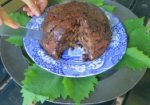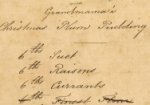‘In December…’
In December, the principal household duty lies in preparing for the creature comforts of those near and dear to us, so as to meet old Christmas with a happy face, a contented mind, and a full larder; and in stoning the plums, washing the currants, cutting the citron, beating the eggs, and mixing the pudding, a housewife is not unworthily greeting the genial season of all good things.
Isabella Beeton, Beeton’s Book of Household Management, 1861
Christmas Plum Pudding
While the ‘traditional’ turkey and cranberry sauce may have conceded to seafood and mangoes in many Australian households, plum puddings are still synonymous with Christmas, even in the Australian summertime. And, despite the prices we are charged in gourmet grocers, they are surprisingly simple to make.
For several years now I’ve hosted Christmas Pudding workshops in the colonial kitchen at Vaucluse House and after much testing of 19th century recipes, this Plum Pudding recipe won hands down! No sugar is added – the sweetness comes from the fruit – and no flour – breadcrumbs are used instead – giving it a very light texture.
It’s taken from Mrs Beeton’s original 1861 edition, receipt number 1328, but I’ve modified it for modern convenience, substituting butter for suet and tailoring it for store-bought packets of mixed fruit. It may be served with custard, but the ‘rich and excellent’ sauce Beeton recommends for it is extraordinarily decadent and, since Christmas is only once a year, I highly recommend you try it.
The laundry copper
Many families have memories of their mothers and grandmothers boiling puddings in the outdoor copper, stirring them around with a length of dowel. I’d always thought this was a very sensible way of keeping the kitchen cooler in summer, but if Dickens’ A Christmas Carol is any indicator, it was common practice in Britain as well.
Hallo! A great deal of steam! The pudding was out of the copper. A smell like a washing-day! That was the cloth. A smell like an eating-house and a pastrycook’s next door to each other, with a laundress’s next door to that! That was the pudding. In half a minute Mrs Cratchit entered: flushed, but smiling proudly: with the pudding, like a speckled cannon-ball, so hard and firm, blazing in half of half-a-quartern of ignited brandy, and bedight with Christmas holly stuck into the top.
Oh, a wonderful pudding! Bob Cratchit said, and calmly too, that he regarded it as the greatest success achieved by Mrs Cratchit since their marriage. Mrs Cratchit said that now the weight was off her mind, she would confess she had had her doubts about the quantity of flour. Everybody had something to say about it, but nobody said or thought it was at all a small pudding for a large family.
Charles Dickens, A Christmas Carol, 1843
A labour of love
Family accounts from 1844 show that the Wentworths spent almost £4 on dried fruit – currants, raisins and peel – and spices in the month leading up to Christmas. Market records indicate that these were then between 6d and 9d per pound, so taking an average, they must have bought over 100 lbs of fruit (45 kgs). They purchased more modest quantities in January, so the pre-Christmas stores must have been put to good use!
The same ledger shows that they bought in mince pies, so it’s more than likely that they were making Christmas puddings – possibly as gifts for their workers as well as for family consumption. Making a pudding from scratch might seem a masterful feat, even for the domestic god(dess), but we are more than fortunate these days to have had most of the hard work done for us, as Elizabeth David so astutely pointed out in her superb book, Spices, Salt and Aromatics in the English Kitchen, first published in 1970:
Have you ever actually made Christmas pudding, in large quantities, by Old English methods? Have they for instance ever tried cleaning and skinning, flouring, shredding, chopping beef kidney suet straight off the hoof? Have they ever stoned bunch after bunch of raisins hardly yet dry on the stalk and each one as sticky as a piece of war toffee? And how long do they think it takes to bash up three pounds of bread-crumbs without an oven to in which they make could first dry the loaves? Come to that, what would they make of an attempt to boil, and to keep on the boil for nine or ten hours on two charcoal fires let into holes in the wall, some dozen large puddings?
Even more fortunate for us is that it would be unlikely that we’d be making ‘some dozen large puds’ as the kitchen staff at Vaucluse House must have been doing in 1844, working their way through 45 kilograms of fruit.
Video: making pudding in the Elizabeth Farm kitchen
Part 1: breadcrumbs, butter and eggs
Part 2: spices and the pudding bowl
Part 3: folding foil and tying string
Part 4: using skewers and cooking
Mrs Beeton’s Christmas plum pudding
| Meal type | Dessert |
| Occasion | Christmas |
| Region | British |
| From book | Beeton's Book of Household management edited by Mrs Isabella Beeton |
Ingredients
- 750g good-quality mixed dried fruit
- 1/2 cup fragrant black tea (optional) (e.g. Earl Grey, Lady Grey, orange pekoe)
- 250g fresh breadcrumbs, made from a 2-day-old white unsliced loaf, crusts removed
- 200g butter (or suet), put in freezer for 1–2 hours
- 1 tablespoon mixed spice
- 1 teaspoon ground nutmeg
- 6 eggs (well beaten)
- 1/2 cup brandy
- boiling water
Note
'On Christmas-day a sprig of holly is usually placed in the middle of the pudding, and about a wine-glassful of brandy poured round it, which, at the moment of serving, is lighted, and the pudding thus brought to table encircled in flame.'
So says Isabella Beeton in 1861, in her best-selling Beeton’s book of household management (1861). I've adapted her 'Christmas plum pudding (very good)' for modern measurements, replaced suet with butter, and added some extra spice now synonymous with Christmas.
Serves 12
Directions
| If the fruit looks dry and shrivelled rather than plump, soak it in the tea for at least a few hours, or overnight. | |
| Grease a 1.5-litre (6-cup) capacity pudding basin, or equivalent smaller bowls, with butter. Cut a round of baking paper the same size as the rim of the bowl. Prepare a double layer of foil to form a 2-cm pinch pleat along the centre, allowing for pressure as the pudding cooks. Put a trivet in the base of a saucepan that is deep enough to hold the pudding basin while still able to be covered with the saucepan lid. | |
| Put the breadcrumbs in a large bowl and, using a grater that has been chilled in the fridge for 30 minutes, grate the frozen butter into the breadcrumbs. Mix through lightly with a knife. Add the spices and fruit (or soaked fruit, drained of excess liquid). | |
| Add the eggs and brandy, and encourage everyone in the family to stir the mixture (an old tradition). | |
| Spoon the mixture into the pudding basin, just short of the rim as the mixture may swell during cooking. Cover the surface of the pudding with the baking paper and cover the basin with the foil, tying securely with string. Put the basin on the trivet in the pan and add enough boiling water to reach halfway up the side of the basin to create a water bath. | |
| Cover the pan and simmer for 6 hours, topping up with boiling water as needed. (Nineteenth-century recipes for Christmas pudding invariably recommend cooking for 6 hours to ensure a rich colour.) | |
| Cool to room temperature then refrigerate until required. To reheat, simmer the pudding in the basin in boiling water for 1 hour or until heated through. Remove the foil and paper, run a knife around the inside of the bowl, and carefully invert the pudding onto a serving plate. It should be a rich dark colour but have a light and moist texture. Top with a sprig of holly, or some homemade fruit mince mixed with chopped walnuts. Douse the pudding with brandy and set it alight just before serving, if desired. | |
| Pour plum pudding sauce over and enjoy! | |
| COOK'S TIPS: Use a fairly robust loaf of bread, as commercial white loaves containing 'stay fresh' additives won't dry out enough and you might end up with a wet and soggy pudding. Chill the grater before grating the butter. If you put the grater in the freezer, make sure you wear rubber gloves when taking it out, to avoid giving your fingers a cold 'burn'. Alternatively, you could grate the butter in a food processor, first chilling the grating plate – it's messy and wasteful, but much easier! | |
Pleating the foil
Mrs Beeton’s original ‘receipt’, 1861
CHRISTMAS PLUM-PUDDING (Very Good)
1328. INGREDIENTS – 1–1/2 lb. of raisins, 1/2 lb. of currants, 1/2 lb. of mixed peel, 3/4 lb. of bread crumbs, 3/4 lb. of suet, 8 eggs, 1 wineglassful of brandy.Mode.—Stone and cut the raisins in halves, but do not chop them; wash, pick, and dry the currants, and mince the suet finely; cut the candied peel into thin slices, and grate down the bread into fine crumbs. When all these dry ingredients are prepared, mix them well together; then moisten the mixture with the eggs, which should be well beaten, and the brandy; stir well, that everything may be very thoroughly blended, and press the pudding into a buttered mould; tie it down tightly with a floured cloth, and boil for 5 or 6 hours. It may be boiled in a cloth without a mould, and will require the same time allowed for cooking.
As Christmas puddings are usually made a few days before they are required for table, when the pudding is taken out of the pot, hang it up immediately, and put a plate or saucer underneath to catch the water that may drain from it. The day it is to be eaten, plunge it into boiling water, and keep it boiling for at least 2 hours; then turn it out of the mould, and serve with brandy-sauce. On Christmas-day a sprig of holly is usually placed in the middle of the pudding, and about a wineglassful of brandy poured round it, which, at the moment of serving, is lighted, and the pudding thus brought to table encircled in flame.
Time.—5 or 6 hours the first time of boiling; 2 hours the day it is to be served.
Average cost, 4s.
Sufficient for a quart mould for 7 or 8 persons.
Seasonable on the 25th of December, and on various festive occasions till March.Note.—Five or six of these puddings should be made at one time, as they will keep good for many weeks, and in cases where unexpected guests arrive, will be found an acceptable, and, as it only requires warming through, a quickly-prepared dish. Moulds of every shape and size are manufactured for these puddings, and may be purchased of Messrs. R. & J. Slack, 336, Strand.
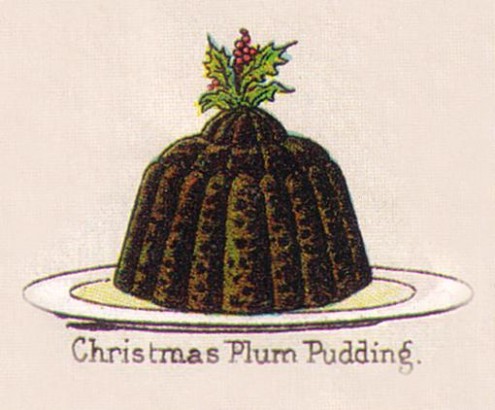
Christmas plum pudding illustrated in Mrs Isabella Beeton, Beeton’s every-day cookery and housekeeping book, Ward, Lock & Co, London, 1895. Caroline Simpson Library & Research Collection, Historic Houses Trust
499. PLUM-PUDDING SAUCE
INGREDIENTS – 1 wineglassful of brandy, 2 oz. of very fresh butter, 1 glass of Madeira, pounded sugar to taste.
Mode.—Put the pounded sugar in a basin, with part of the brandy and the butter; let it stand by the side of the fire until it is warm and the sugar and butter are dissolved; then add the rest of the brandy, with the Madeira. Either pour it over the pudding, or serve in a tureen. This is a very rich and excellent sauce.
Average cost, 1s. 3d. for this quantity.
Sufficient for a pudding made for 6 persons.
To serve, Mrs Beeton instructs:
On Christmas-day a sprig of holly is usually placed in the middle of the pudding, and about a wineglassful of brandy poured round it, which, at the moment of serving, is lighted, and the pudding thus brought to table encircled in flame.
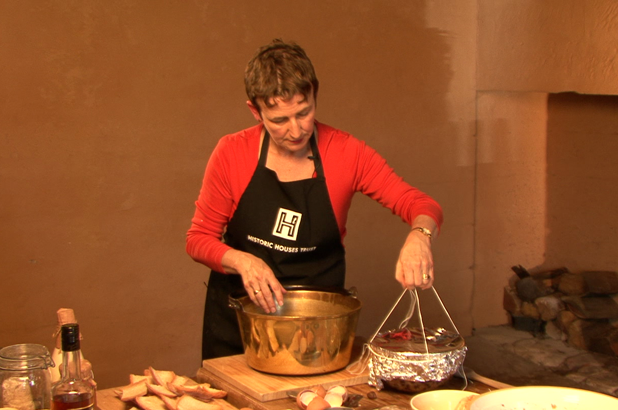
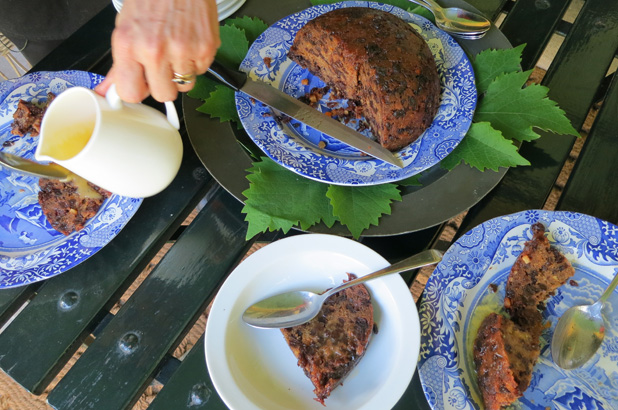
 Print recipe
Print recipe





